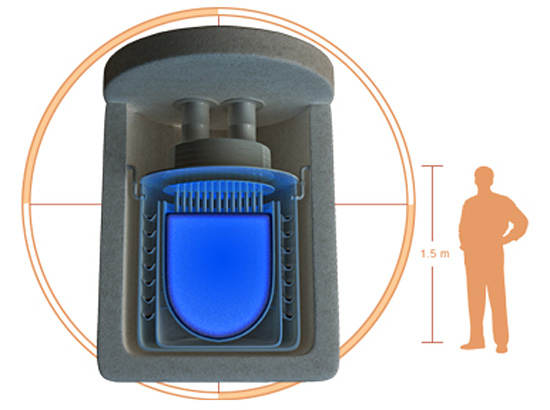
Just for moment let’s consider, in quick bullet fashion, some of the energy problems we face:
- We continue to need increasing amounts of energy. Increased energy means increased prosperity. Simple as that.
- Much of our energy is currently produced by burning fossil fuels, e.g. coal, oil, or natural gas.
- We’re importing an increasing proportion of our oil from parts of the world that are unstable, unfriendly, or both.
- Whether global warming presents the imminent danger of which some climate scientists, politicians, and activists warn, releasing ever-increasing amounts of carbon dioxide into the atmosphere can’t be a good thing.
- Lots of people are afraid, rationally or irrationally, of nuclear reactors in their neighborhoods.
- The legal and regulatory environments in the United States don’t favor building new nuclear power plants.
- An AP1000 type nuclear power plant costs between $5 billion and $10 billion and five years or more to build.
- Wind and solar power tend to be most effective where they’re needed least.
- We’ve probably already potentialized hydroelectric power in the United States.
- The stagnant water that accumulates behind hydroelectric dams produces lots of methane, i.e. it isn’t enormously cleaner than generating power from fossil fuels and under certain circumstances may even be worse.
- There are lots of promising new technologies for power generation and/or power storage coming up, e.g. cellulosic ethanol and producing fuel via biological activity, but they remain tantalizingly in the future.
There is a technology for which orders are being taken now for delivery beginning in 2013 that has the potential to solve a significant number of these problems: small scale nuclear power generation.
Imagine a self-contained nuclear power plant about the size of a minivan, buried underground, requiring no maintenance. One example of the technology is the modular “nuclear battery” being produced by Hyperion Power Generation. There’s a good article on these devices here.
A device of this type sidesteps most of the complaints about nuclear power generation. It’s inherently safe and secure, it’s buried underground and, consequently, invisible, its modular structure presents a nominal construction lead time, and, importantly, with its $25 million price tag, it’s a lot easier to finance than what we usually think of as a nuclear power station. Among other things that means that its potential customer base is a lot larger.
This approach is not without problems. For example, there may be a bottleneck in the production of its uranium hydride fuel. The more important problem will probably be regulatory—the plan is still awaiting approval and I suspect that Westinghouses of the nuclear energy world may throw up what roadblocks they can to prevent new kids from poaching in their neighborhood.
I doubt that waste disposal will be the problem with this approach that it is with old technology nuclear power generation since the spent fuel is most likely to be reprocessed into new uranium hydride. I also think that’s why its designers and developers think of it as a nuclear battery rather than as conventional nuclear power generation.
Small, discrete, modular nuclear power generation has many advantages over our current system. Beyond the advantages I’ve listed above it lends itself better to redundancy and would be more resilient to attack or disaster than the old large scale nuclear technology. We have a model for such a dispersed, redundant, resilient system, the Internet, and a new power system could be implemented the same way the Internet has been: piecemeal.
I continue to think that the energy future will be a more diverse one than the energy past, dominated by coal, oil, hydroelectric, and nuclear has been. The old technologies must be augmented and, where appropriate, supplanted by wind, solar, geothermal, and other approaches. And in that new, diverse energy future small scale nuclear power generation may plan an important role.
Dave Schuler, an independent businessman, blogs at The Glittering Eye, where this essay previously appeared.
Image: hyperion-nuclear-power.jpg
